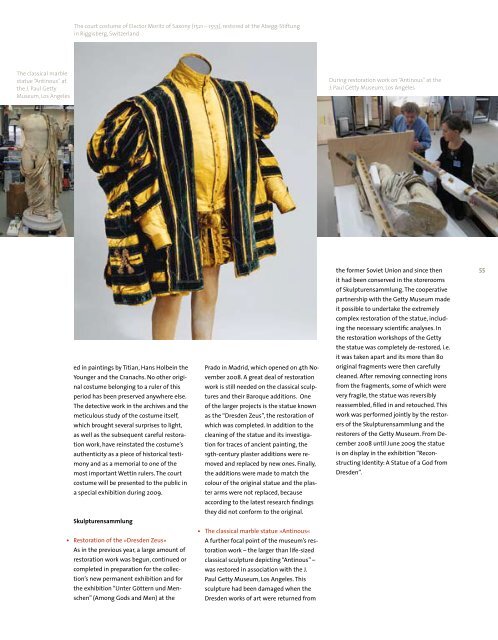2008 - Staatliche Kunstsammlungen Dresden
2008 - Staatliche Kunstsammlungen Dresden
2008 - Staatliche Kunstsammlungen Dresden
Create successful ePaper yourself
Turn your PDF publications into a flip-book with our unique Google optimized e-Paper software.
The classical marble<br />
statue “Antinous” at<br />
the J. Paul Getty<br />
Museum, Los Angeles<br />
The court costume of Elector Moritz of Saxony (1521 – 1553), restored at the Abegg-Stiftung<br />
in Riggisberg, Switzerland<br />
ed in paintings by Titian, Hans Holbein the<br />
Younger and the Cranachs. No other original<br />
costume belonging to a ruler of this<br />
period has been preserved anywhere else.<br />
The detective work in the archives and the<br />
meticulous study of the costume itself,<br />
which brought several surprises to light,<br />
as well as the subsequent careful restoration<br />
work, have reinstated the costume’s<br />
authenticity as a piece of historical testimony<br />
and as a memorial to one of the<br />
most important Wettin rulers. The court<br />
costume will be presented to the public in<br />
a special exhibition during 2009.<br />
skulpturensammlung<br />
• Restoration of the »<strong>Dresden</strong> Zeus«<br />
As in the previous year, a large amount of<br />
restoration work was begun, continued or<br />
completed in preparation for the collection’s<br />
new permanent exhibition and for<br />
the exhibition “Unter Göttern und Menschen”<br />
(Among Gods and Men) at the<br />
Prado in Madrid, which opened on 4th November<br />
<strong>2008</strong>. A great deal of restoration<br />
work is still needed on the classical sculptures<br />
and their Baroque additions. One<br />
of the larger projects is the statue known<br />
as the “<strong>Dresden</strong> Zeus”, the restoration of<br />
which was completed. In addition to the<br />
cleaning of the statue and its investigation<br />
for traces of ancient painting, the<br />
19th-century plaster additions were removed<br />
and replaced by new ones. Finally,<br />
the additions were made to match the<br />
colour of the original statue and the plaster<br />
arms were not replaced, because<br />
according to the latest research findings<br />
they did not conform to the original.<br />
• The classical marble statue »Antinous«<br />
A further focal point of the museum’s restoration<br />
work – the larger than life-sized<br />
classical sculpture depicting “Antinous” –<br />
was restored in association with the J.<br />
Paul Getty Museum, Los Angeles. This<br />
sculpture had been damaged when the<br />
<strong>Dresden</strong> works of art were returned from<br />
During restoration work on “Antinous” at the<br />
J. Paul Getty Museum, Los Angeles<br />
the former Soviet Union and since then<br />
it had been conserved in the storerooms<br />
of Skulpturensammlung. The cooperative<br />
partnership with the Getty Museum made<br />
it possible to undertake the extremely<br />
complex restoration of the statue, including<br />
the necessary scientific analyses. In<br />
the restoration workshops of the Getty<br />
the statue was completely de-restored, i.e.<br />
it was taken apart and its more than 80<br />
original fragments were then carefully<br />
cleaned. After removing connecting irons<br />
from the fragments, some of which were<br />
very fragile, the statue was reversibly<br />
reassembled, filled in and retouched. This<br />
work was performed jointly by the restorers<br />
of the Skulpturensammlung and the<br />
restorers of the Getty Museum. From December<br />
<strong>2008</strong> until June 2009 the statue<br />
is on display in the exhibition “Reconstructing<br />
Identity: A Statue of a God from<br />
<strong>Dresden</strong>”.<br />
55

















